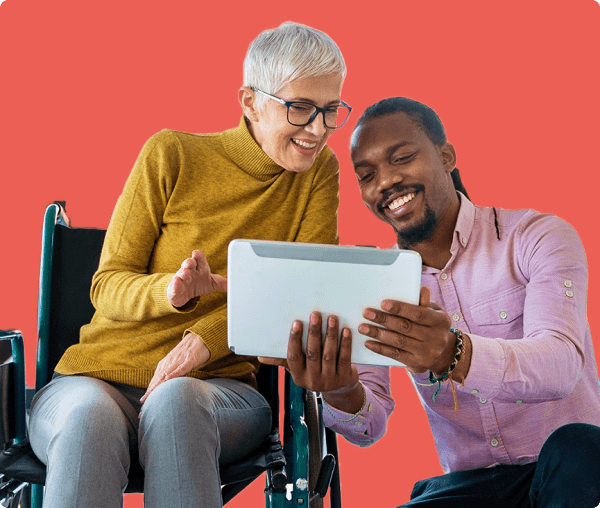Advancing economic mobility in your community
 Gohar Chichian
·
4 minute read
Gohar Chichian
·
4 minute read

What is economic mobility?
Economic mobility is often described as how a person’s financial well-being changes over a lifetime. As a person’s income increases, they are considered upwardly mobile.
Upward mobility is influenced by an individual’s community, neighborhood, geographic area, and population group.
Philanthropy’s role in economic mobility

In philanthropy, BIPOC nonprofit leaders are faced with unique challenges every day –– yet face a pervasive funding gap to address community needs and solutions.
A survey by the Nonprofit Finance Fund found a staggering discrepancy in funding and demand between BIPOC-led and White-led organizations:
- 64% of BIPOC-led organizations have experienced a significant increase in demand over the last two years, compared to only 47% of White-led organizations.
- 71% of White-led organizations received corporate donations compared to only 58% of BIPOC-led nonprofits.
- 86% of White-led organizations received foundation money compared to 75% of Black-led organizations and 82% of BIPOC-led organizations.
This leads to significant disparities between Black-led and White-led early-stage nonprofits:
- 24% less revenue is generated by Black-led nonprofits on average when compared to White-led nonprofits.
- 76% less unrestricted net assets are owned by Black-led nonprofits when compared to White-led nonprofits.
Why addressing inequities in economic mobility is essential
Nonprofit organizations are crucial to creating economic opportunities in communities and helping drive wealth over time. The stark realities of racial disparities in philanthropy and chronic underfunding of BIPOC-led nonprofits demonstrate the urgent need for greater investment and support.Echoing Green and The Bridgespan Group named four barriers that BIPOC organizations and leaders experience “across the full arc of fundraising efforts” in their 2020 report Racial Equity and Philanthropy: Disparities in Funding for Leaders of Color Leave Impact on the Table:
- Getting connected to potential funders: Leaders of color have inequitable access to social networks that enable connections to the philanthropic community.
- Building rapport with potential funders: Interpersonal bias can manifest as mistrust and microaggressions, which inhibit relationship building and emotionally burden leaders of color.
- Securing support for the organization: Funders often lack understanding of culturally relevant approaches, leading them to over rely on specific forms of evaluation and strategies with which they are familiar.
- Sustaining relationships with current funders: Grant renewal processes can be arduous if mistrust remains, and funding may stop if the funder has a White-centric view of what is a strategic priority and how to measure progress.
Actionable tips for grantmakers

Invest in BIPOC leaders
Go beyond one-off gestures and commit to investing in BIPOC leadership. By providing resources, mentorship, and leadership development opportunities, grantmakers can cultivate a pipeline of diverse leaders equipped to navigate the complex challenges facing BIPOC communities.Embrace innovation
Fostering an environment that encourages innovation and creativity within BIPOC-led nonprofits is essential for driving meaningful progress in economic mobility and workforce development.Foster collaboration
Encourage collaboration and partnership among organizations serving BIPOC communities, leveraging collective expertise and resources for greater impact.Prioritize BIPOC-led nonprofits focused on economic development
By investing in BIPOC-led nonprofits, philanthropy has the opportunity to channel resources directly into the hands of those most impacted, fostering empowerment and resilience within the community.Listen and learn
Take the time to listen to the needs and priorities of BIPOC communities, centering their voices in your decision-making process.How Catchafire supports BIPOC communities through capacity building

Catchafire serves as a resource to help you scale your grantmaking investment and go beyond traditional capacity building grants. In the United States, only 25% of all nonprofit executive directors are BIPOC. At Catchafire, 61% of nonprofits on our platform have BIPOC leadership and 32% are exclusively Black-led.
Nonprofit capacity building requires a multifaceted approach, and scaling up resources for BIPOC-led nonprofits addresses both financial and capacity building needs.
Catchafire and grantmakers work together by:
- Providing flexible funding that allows organizations to respond dynamically to community needs and pursue long-term strategic initiatives.
- Offering organizational capacity building support, including technical assistance, leadership development programs, and networking opportunities.
- Providing funding and support for capacity building initiatives strengthens the effectiveness of BIPOC-led nonprofits, contributing to long-term gains related to economic development.
- Prioritizing partnerships with BIPOC-led nonprofits and integrating their voices and perspectives into decision-making processes.
“I’m a one woman show and I’m able to be that because of Catchafire.”
Lisa Woolfork
Founder, Black Women Stitch
With access to Catchafire, Black-led nonprofits receive:
Coaching and consulting
Access to thousands of volunteers to provide project support to grow in directions important to the nonprofit. BIPOC-led nonprofits receive support on projects like board prospecting, marketing strategy, and partnership proposals, helping them to advance their programs and mission in service of their communities.Networking and collaboration opportunities
Catchafire hosts regular convenings to help leaders of color more easily stand up together through peer-to-peer learning, coaching, and resources.Nonprofits receive access to a BIPOC leadership group with learning sessions, peer conversations (coined “Let’s Talk About It”), and panel discussions to engage fully with the experience of being a BIPOC leader in the nonprofit space.
Sustainability
Our team of experts have designed project templates for every need, including areas like business plan reviews, organizational goal setting, and program assessment.These strengthen nonprofits’ long-term programming, finances, and organizational strategy, supporting their overall sustainability.
Leadership and development tools
Members receive coaching and support for organizational needs like strategic planning, marketing strategy, and finance, providing instant takeaways to apply to their organizations.As a result, 87.5% of BIPOC leadership group attendees report an increased confidence in nonprofit leadership skills.
“If it hadn't been for Catchafire, we wouldn't exist. Catchafire has impacted our operational tasks and has allowed us to rally support to help push our mission. Since completing our projects, we are more organized and now run like a well-oiled machine.”
Rashard Dobbins
CEO and Co-Founder, Class Act Detroit
The importance of prioritizing BIPOC communities and investing in economic mobility has never been clearer. It is philanthropy’s collective responsibility to amplify the voices of BIPOC communities, dismantle systemic barriers, and pave the way for a more equitable and inclusive future.
Together, we can build a world where economic mobility is not just a dream but a reality for every individual and family, regardless of race or background.



